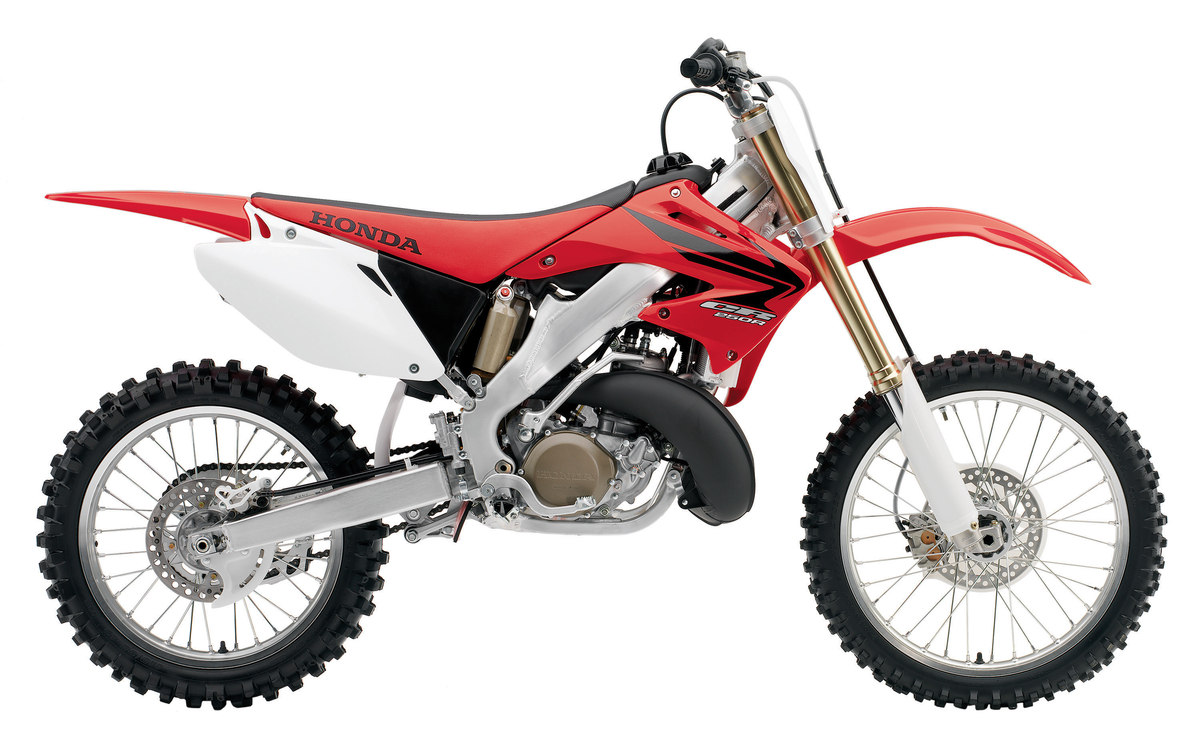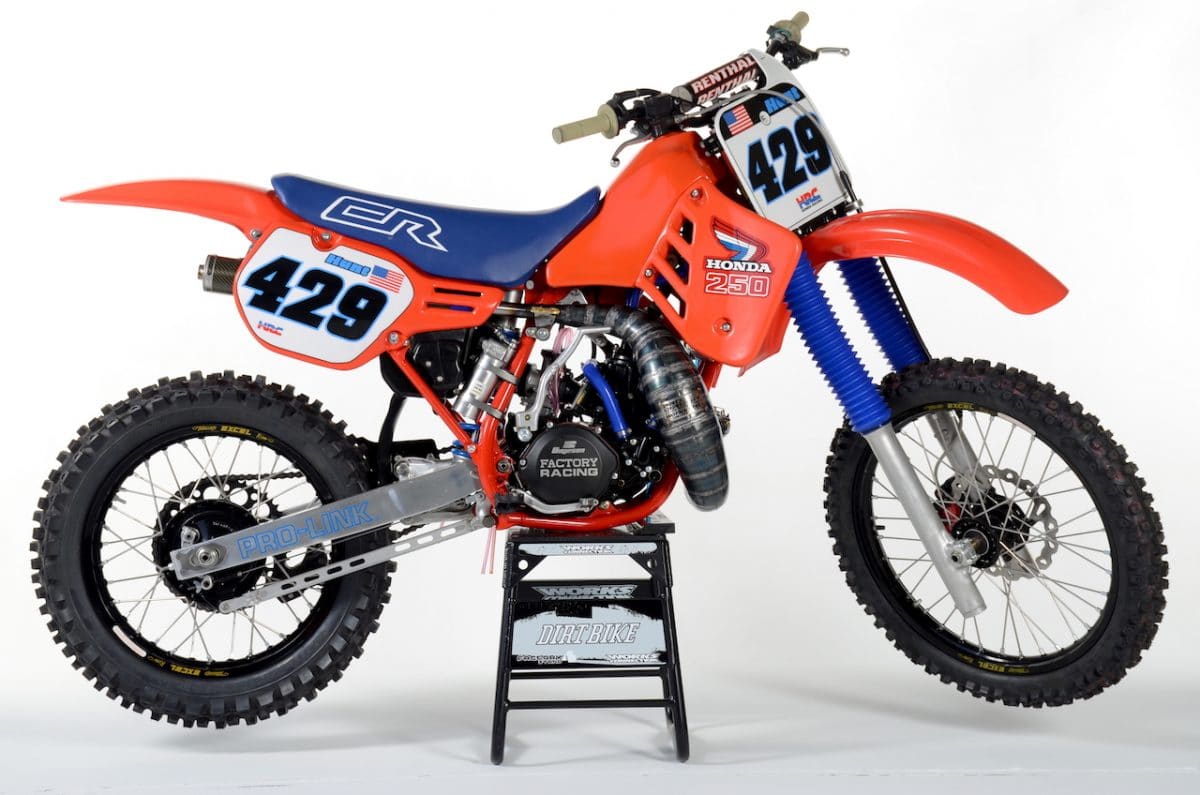In that 34-year run, the Honda evolved through many forms, completely changing its identity several times. The early models are sought after in vintage racing, and the later ones are still competitive against four-strokes.

Supercross championships: 15
Outdoor national championships: 12
First title: Gary Jones, 1973 250 National Championship.
Most recent title: Ricky Carmichael, 2003 250 National Championship.
The catalog of riders who won on the CR250 is a who’s who of American motocross: Gary Jones, Marty Tripes, Marty Smith, Bob Hannah, Donnie Hansen, David Bailey, Johnny O’Mara, Rick Johnson, Jeff Stanton, Jean Michel Bayle, Danny LaPorte, Chuck Sun, Jeremy McGrath, Doug Henry, Mike LaRocco, Ricky Carmichael and many, many others. In fact, it’s interesting to note that since Honda switched to the four-stroke CRF450R as its mainstay, the factory team has only earned one outdoor national Championship: R.C. in 2004. So it goes.
On the off-road side of the coin, the Honda 250 was incredibly successful on local levels, but not nationally. Honda never promoted the bike for off-road use, instead concentrating on the XR line for GNCC and Baja racing. The only time CR250s got attention on the National Enduro scene was when Kevin Hines raced them under the CRE name, which lasted a number of years in the late ‘90s.

A BRIEF HISTORY OF TIME
It seems odd, but the Honda CR250 can trace its roots back to the RC166 six-cylinder, 250cc road racer that Mike Hailwood rode in Europe. Terry Good’s website www.mxworksbike.com has an excellent history of how all this came about. Soichiro Honda was fanatical about winning races at any cost, so he put together a team of the best engineers to go GP racing. Within a few years, the team had achieved all its goals. The cost of doing this was incredible, so after winning in 1966, Honda pulled out of GP racing 1967. That left a team of very talented and energetic engineers without much to do. At the time, Mr. Honda hated two-strokes and publicly said that his company would never build one. But the engineers knew that the two-stroke motor was the way of the future and set about building one secretly. To this day, it’s not known how much Mr. Honda himself knew about the project. In August 1971, the team took the prototype to a National race in Mine, Yamaguchi, hoping not to attract much attention. Unfortunately, the bike was photographed by the Japanese press, and soon Honda’s two-stroke was out of the bag. Soichiro begrudgingly gave the go-ahead to make the machine an official Honda project, at first called the 335c. Two years later, the Honda CR250M arrived in dealers, and Honda won its first U.S. National Championship with Gary Jones. That first year, the Honda 250 two-stroke was a complete game-changer, and it set off a frenzied era of hyper evolution in the MX world. For the original test of the Honda CR250M, as it appeared in Dirt Bike Magazine of June, 1973, click here.
MAJOR MODEL CHANGES

Early ‘70s: Unfortunately, the CR250M didn’t keep pace through the early ‘70s. It was offered almost unchanged in 1973 and 1974, then received a conservative makeover in 1975. That allowed Yamaha, Suzuki and European makers to regain the high ground. In the meantime, Honda’s factory racing team was riding something completely different.

1978: Honda released a stunning new 250cc two-stroke, redubbing it the CR250R. It had a Euro-style engine with the output shaft on the right and a reed-valve intake. Probably the most memorable aspect of the bike was its striking appearance. Everything, even the motor was fire-engine red. Honda leapfrogged back to the front of the field in magazine shootouts and sales. The following year, the 250 was spared the 23-inch front wheel that came on the 125 and several other models.

1981: Honda predicted the coming of liquid-cooling and single-shock suspension, and rushed to meet the call The 1981 Honda CR250R leaped yearsahead–in fact, it was too advanced. It was a little too much too soon, and this actually became a rare year not to own a Honda. It had reliability problems and the new Pro-Link rear suspension didn’t work well. Once again, Honda lost its edge in the 250 class. Over the next two years, the bike received back-to-back changes on a fairly large scale and most of the problems were sorted out, making ‘83 a very good year to ride a CR.

1984: Another massive year for redesign; this is when the Honda CR250R settles down into a familiar form that it would hold for many years. The motor was turned around with the countershaft returning to the left. The bike received the ATAC exhaust valve and a hydraulic front disc brake, which is a watermark in the vintage-racing world today.
For the next six years, Honda made one or two significant changes every season. In 1986 it was a cartridge front fork and a more modern exhaust valve, called the “Honda Power Port.” In 1987 it got a hydraulic rear disc brake and the Keihin carb was increased from 36mm to 38mm. Most significant of all was the change to an inverted Showa fork in 1989. This was considered a step backward at first. Within a few seasons, the new front suspension design was accepted. Even that 1989 version could be made to work much better than stock once suspension tuners figured it out.
1990: This was a big cosmetic change for the Honda, but it should be pointed out that massive redesigns became less frequent in this era. The 1990 machine got all-new body work, a white frame and upgrades in suspension. It sold for $3995. After that came a brief period that most riders try to forget. We entered the splash years. The most offensive look came in 1991, which was virtually a mullet on wheels.
In 1992, the motor became more powerful and the frame became weaker. This was a bad combination for handling, which most riders blamed on the suspension. Roger DeCoster came to work for Dirt Bike Magazine a few years later and explained what had taken place behind closed doors at Honda. He had been badgering the engineers for a stronger frame throughout these years, but it didn’t come until 1994. Unfortunately Jeremy McGrath still preferred the handling of the older frame–once it had been gusseted for more stiffness. According to DeCoster, Jean Michel Bayle had a gift for developing and setting up race bikes. So the race team’s CR250R from the early ‘90s, was the mainstay of Honda’s racing effort for years afterward, and was the version that McGrath rode throughout his Honda career. In 1995, Honda made a shocking switch to KYB suspension, although Roger pointed out that it felt about the same. The price by then had gone up to $5099.
Some say the best year in the entire run of Honda CR250Rs was 1996. Even though that model wasn’t significantly changed, it was the end product of an accumulation of upgrades. McGrath had gone to Suzuki by that time, and so had Roger DeCoster, even though he was still writing stories for Dirt Bike.
1997: Everything changed with the coming of aluminum. The 1997 Honda CR250R was a mind-blower with its twin-beam aluminum frame, base on technology Honda had gleaned from the superbike world. Not only was the frame new, but the motor had a heavy re-do and the bike was nothing like its predecessor. But it was like 1981 all over again. The bike was not well received. It was a very harsh-riding machine with a top-end motor. Only Pro riders warmed to it, which sent Honda’s R&D team back to the drawing board immediately. For two years they could only make minor changes while a new frame was prepared. In this period, the Yamaha YZ250 hit its stride in most magazine tests.
2000: The second-generation aluminum frame finally arrived, and it brought in another period where Honda was on top. It was the lightest and fastest, and even though some DB test riders of the time still preferred the Yamaha YZ250, it was a very close call.

2002: Everything changed again, and once again the Honda suffered a set back. The 2002 CR250R got a new motor with an electronic power valve. It looked good on the dyno but that never translated to a good feel on the track. The Honda motor just felt sleepy. Power was an area where the Honda had long shined, but that would never be the same again. The frame and suspension, on the other hand, were excellent, basically not that different from the stuff on modern Honda four-strokes.
After that, the handwriting was on the wall–there would be no further development of the CR250R coming, only minor updates. In the spirit of Soichiro Honda, the company made an announcement that it would make no more two-strokes after 2007, thus ending the greatest dynasty in the history of motocross.

TODAY
Even though the final years of the CR250R were not its best, they still do well on the track. In the used-bike market, they proved to be almost unbreakable. The electronic power valve, it was found, was driven by an underpowered motor. On the works level, Honda quickly found out how to make the motor sing, but the change was never put into production. Any good engine tuner can make a late model CR fly.

Those last models are still competitive. Some riders consider the real prizes on the used market to be the models from 2000 to 2001. Those are like gold to those who knows what they are. Yet in classified ads, you commonly see them selling for around $1800. Going back a few years, the 1996 version is a keeper, although with any 15-year-old bike, condition is more important than model. You can find gems for under $1000.

A far as vintage and evolution racing is concerned, in each era, the Honda is near the top of the wanted list. But if those bikes have survived all these years in good shape they will probably command a higher price than new bikes. Well restored ‘83 models bring about $5000 because they are pre disc brake. Same goes for the 1978-1980 models because of their air-cooled engines. The grand prize, of course, is a CR250M. True 1973 models are exceedingly rare, but the kicker is that no one can tell the difference between a ‘73 and a ‘74; the frame numbers are continuous. It’s not unusual to see them bring $10,000.
Will the CR250 ever return? There are whispers of a new two-stroke in the works a Honda. We’re not surprised–almost everything is in the works somewhere at Honda. But if it comes, it won’t be a CR250. It will be something else. The membership in the dirt bike icon club is very exclusive.




Comments are closed, but trackbacks and pingbacks are open.